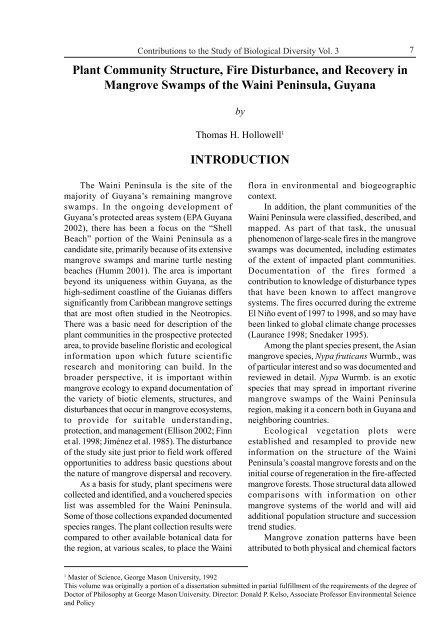Plant Community Structure, Fire Disturbance, and Recovery in ...
Plant Community Structure, Fire Disturbance, and Recovery in ...
Plant Community Structure, Fire Disturbance, and Recovery in ...
You also want an ePaper? Increase the reach of your titles
YUMPU automatically turns print PDFs into web optimized ePapers that Google loves.
Contributions to the Study of Biological Diversity Vol. 3<br />
<strong>Plant</strong> <strong>Community</strong> <strong>Structure</strong>, <strong>Fire</strong> <strong>Disturbance</strong>, <strong>and</strong> <strong>Recovery</strong> <strong>in</strong><br />
Mangrove Swamps of the Wa<strong>in</strong>i Pen<strong>in</strong>sula, Guyana<br />
The Wa<strong>in</strong>i Pen<strong>in</strong>sula is the site of the<br />
majority of Guyana’s rema<strong>in</strong><strong>in</strong>g mangrove<br />
swamps. In the ongo<strong>in</strong>g development of<br />
Guyana’s protected areas system (EPA Guyana<br />
2002), there has been a focus on the “Shell<br />
Beach” portion of the Wa<strong>in</strong>i Pen<strong>in</strong>sula as a<br />
c<strong>and</strong>idate site, primarily because of its extensive<br />
mangrove swamps <strong>and</strong> mar<strong>in</strong>e turtle nest<strong>in</strong>g<br />
beaches (Humm 2001). The area is important<br />
beyond its uniqueness with<strong>in</strong> Guyana, as the<br />
high-sediment coastl<strong>in</strong>e of the Guianas differs<br />
significantly from Caribbean mangrove sett<strong>in</strong>gs<br />
that are most often studied <strong>in</strong> the Neotropics.<br />
There was a basic need for description of the<br />
plant communities <strong>in</strong> the prospective protected<br />
area, to provide basel<strong>in</strong>e floristic <strong>and</strong> ecological<br />
<strong>in</strong>formation upon which future scientific<br />
research <strong>and</strong> monitor<strong>in</strong>g can build. In the<br />
broader perspective, it is important with<strong>in</strong><br />
mangrove ecology to exp<strong>and</strong> documentation of<br />
the variety of biotic elements, structures, <strong>and</strong><br />
disturbances that occur <strong>in</strong> mangrove ecosystems,<br />
to provide for suitable underst<strong>and</strong><strong>in</strong>g,<br />
protection, <strong>and</strong> management (Ellison 2002; F<strong>in</strong>n<br />
et al. 1998; Jiménez et al. 1985). The disturbance<br />
of the study site just prior to field work offered<br />
opportunities to address basic questions about<br />
the nature of mangrove dispersal <strong>and</strong> recovery.<br />
As a basis for study, plant specimens were<br />
collected <strong>and</strong> identified, <strong>and</strong> a vouchered species<br />
list was assembled for the Wa<strong>in</strong>i Pen<strong>in</strong>sula.<br />
Some of those collections exp<strong>and</strong>ed documented<br />
species ranges. The plant collection results were<br />
compared to other available botanical data for<br />
the region, at various scales, to place the Wa<strong>in</strong>i<br />
by<br />
Thomas H. Hollowell 1<br />
INTRODUCTION<br />
flora <strong>in</strong> environmental <strong>and</strong> biogeographic<br />
context.<br />
In addition, the plant communities of the<br />
Wa<strong>in</strong>i Pen<strong>in</strong>sula were classified, described, <strong>and</strong><br />
mapped. As part of that task, the unusual<br />
phenomenon of large-scale fires <strong>in</strong> the mangrove<br />
swamps was documented, <strong>in</strong>clud<strong>in</strong>g estimates<br />
of the extent of impacted plant communities.<br />
Documentation of the fires formed a<br />
contribution to knowledge of disturbance types<br />
that have been known to affect mangrove<br />
systems. The fires occurred dur<strong>in</strong>g the extreme<br />
El Niño event of 1997 to 1998, <strong>and</strong> so may have<br />
been l<strong>in</strong>ked to global climate change processes<br />
(Laurance 1998; Snedaker 1995).<br />
Among the plant species present, the Asian<br />
mangrove species, Nypa fruticans Wurmb., was<br />
of particular <strong>in</strong>terest <strong>and</strong> so was documented <strong>and</strong><br />
reviewed <strong>in</strong> detail. Nypa Wurmb. is an exotic<br />
species that may spread <strong>in</strong> important river<strong>in</strong>e<br />
mangrove swamps of the Wa<strong>in</strong>i Pen<strong>in</strong>sula<br />
region, mak<strong>in</strong>g it a concern both <strong>in</strong> Guyana <strong>and</strong><br />
neighbor<strong>in</strong>g countries.<br />
Ecological vegetation plots were<br />
established <strong>and</strong> resampled to provide new<br />
<strong>in</strong>formation on the structure of the Wa<strong>in</strong>i<br />
Pen<strong>in</strong>sula’s coastal mangrove forests <strong>and</strong> on the<br />
<strong>in</strong>itial course of regeneration <strong>in</strong> the fire-affected<br />
mangrove forests. Those structural data allowed<br />
comparisons with <strong>in</strong>formation on other<br />
mangrove systems of the world <strong>and</strong> will aid<br />
additional population structure <strong>and</strong> succession<br />
trend studies.<br />
Mangrove zonation patterns have been<br />
attributed to both physical <strong>and</strong> chemical factors<br />
1 Master of Science, George Mason University, 1992<br />
This volume was orig<strong>in</strong>ally a portion of a dissertation submitted <strong>in</strong> partial fulfillment of the requirements of the degree of<br />
Doctor of Philosophy at George Mason University. Director: Donald P. Kelso, Associate Professor Environmental Science<br />
<strong>and</strong> Policy<br />
7
















